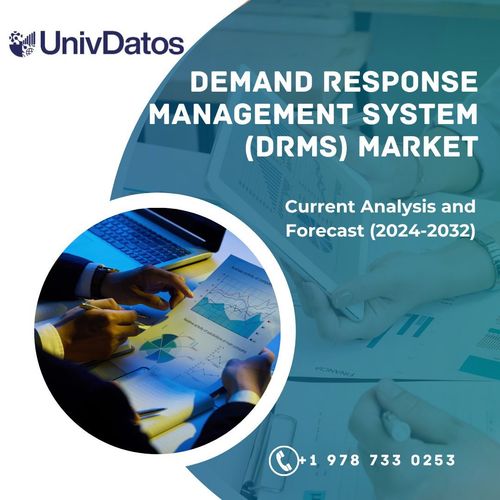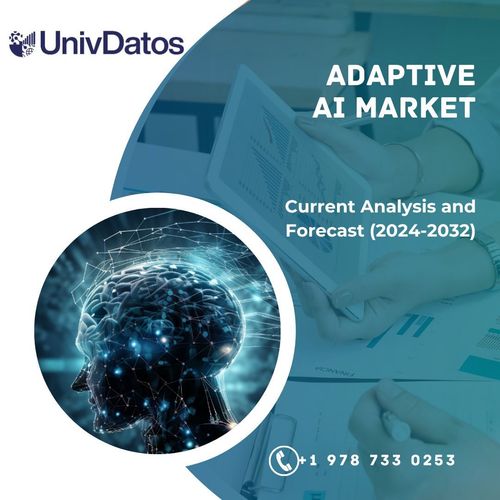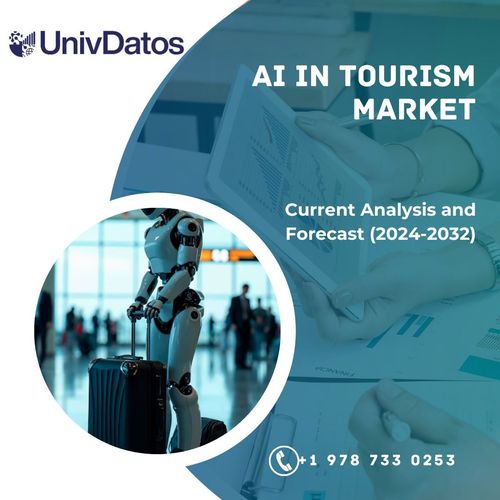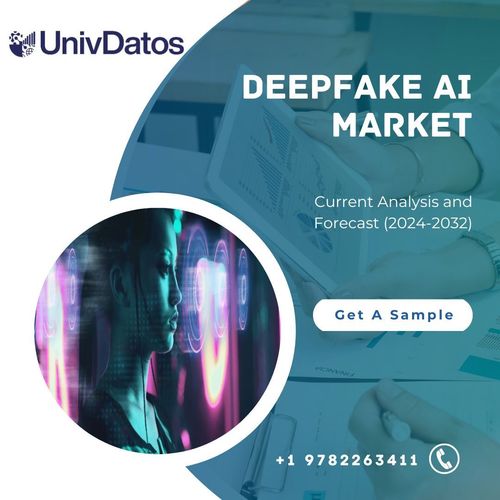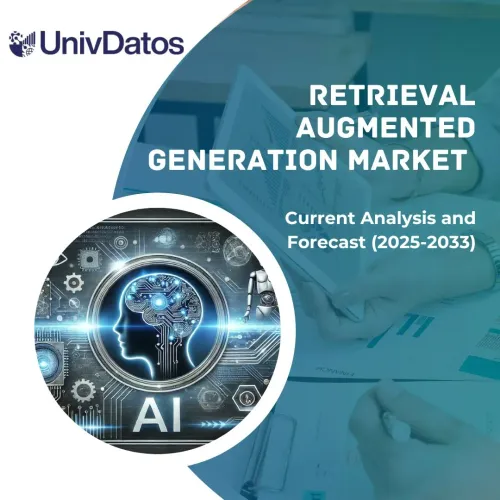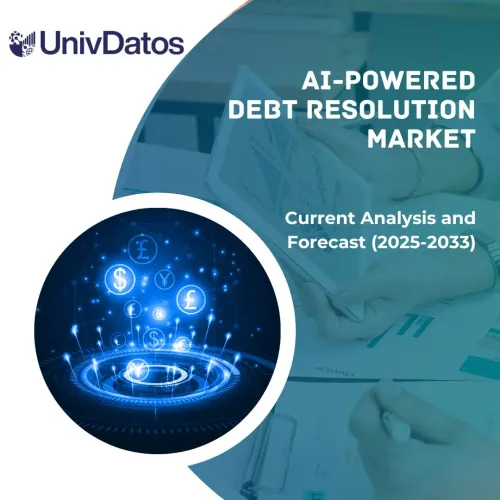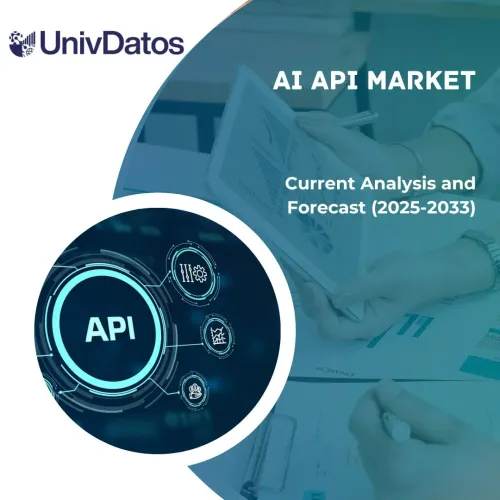- Home
- About Us
- Industry
- Services
- Reading
- Contact Us
AI in Tourism Market: Current Analysis and Forecast (2024-2032)
Emphasis on Type (Air Travel, Rail Travel, Cruise Travel); Deployment Mode (On-Premise, Cloud-Based); Solution (Virtual Assistant & Chatbots, Pricing & Revenue Management, Booking Management System); and Region/Country
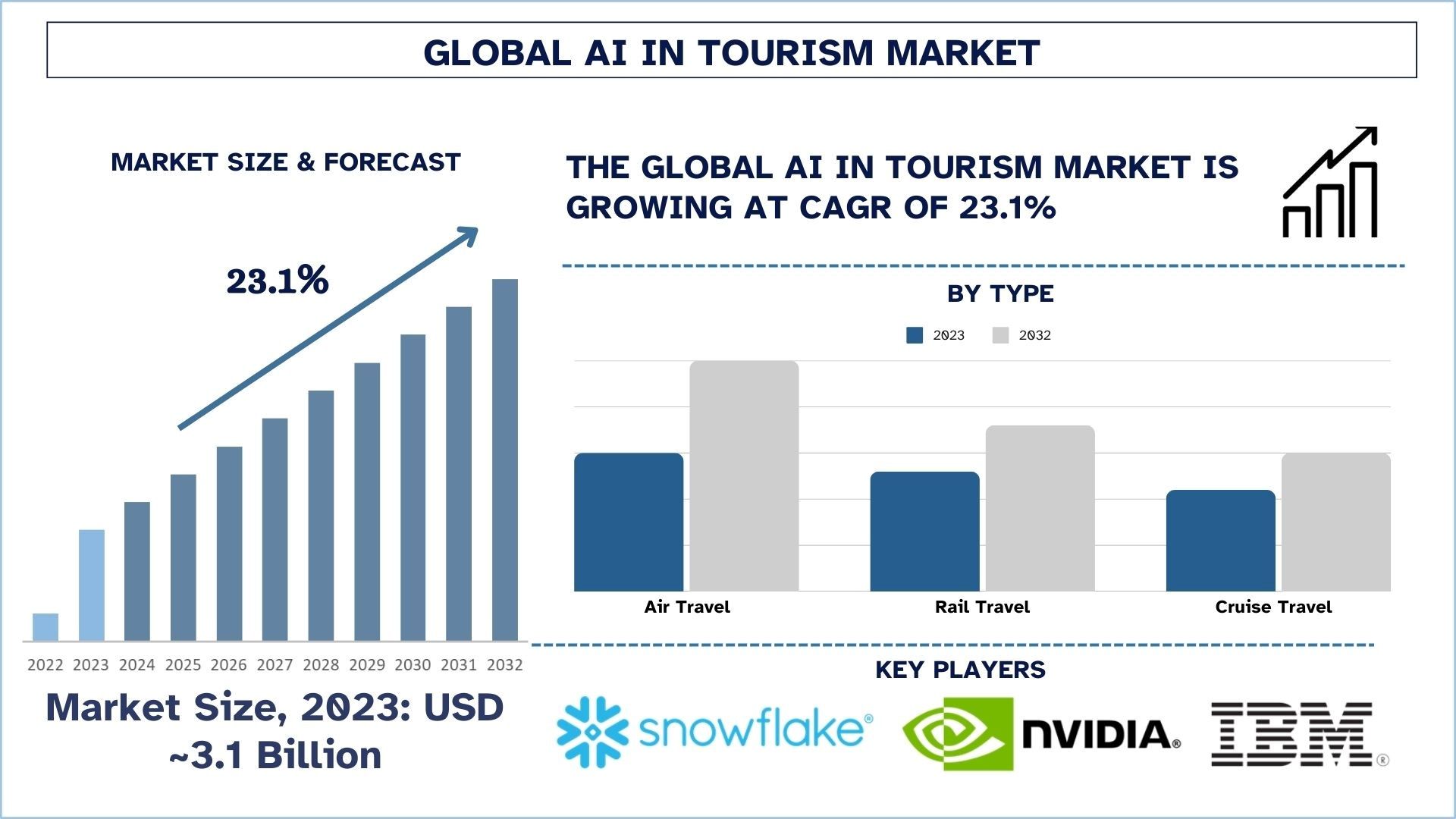
AI in Tourism Market Size & Forecast
The AI in Tourism market was valued at approximately USD 3.1 Billion in 2023 and is expected to grow at a substantial CAGR of around 23.1% during the forecast period (2024-2032) owing to the AI can support efforts to promote sustainable tourism practices.
AI in Tourism Market Analysis
Tourism AI combines artificial intelligence technologies to bring about better travel experiences while optimizing operations and making improved decisions across the industry sector. Customers access support from AI-powered chatbots as well as receive personalized itineraries based on smart recommendations and face recognition technology supports quick check-ins while AI-driven prices adjust dynamically. AI transforms customer interactions and service management for travel agencies together with hotels and airlines and tourism boards through its implementation of natural language processing and machine learning and automation capabilities.
Through AI the tourism industry leads with Expedia and Marriott as well as Airbnb implementing predictive analytics chatbots and personalization abilities to raise operational efficiency and customer engagement. These airlines and OTAs collaborate through Artificial Intelligence systems to predict customer demand and manage real-time pricing structures and implement AI-driven fraud detection protocols and recommendation systems. Tourism boards and smart cities use AI analytical systems to optimize both visitor management systems and marketing approaches.
On December 06, 2024, Wipro Limited (NYSE: WIT, BSE: 507685, NSE: WIPRO), a leading technology services and consulting company, announced a collaboration with SIAM.AI, a member of the NVIDIA Cloud Partner program in Thailand. The companies will leverage NVIDIA accelerated computing and software to develop an AI-powered digital assistant for the Tourism Authority of Thailand. This collaboration will utilize infrastructure, data and networks within the country, advancing Thailand’s sovereign AI objectives.
On July 19, 2023, Tripadvisor®, the world's largest travel guidance platform, announced a significant upgrade to Trips - its core trip planning product - with the introduction of a new AI-powered travel itinerary generator. This new feature (currently in public beta) creates personalized travel itineraries utilizing OpenAI’s generative AI technology. It leverages human insights from over a billion reviews and opinions of the more than eight million businesses listed on Tripadvisor, delivering reliable, trustworthy guidance from its community of real travelers.
AI in Tourism Market Trends
This section discusses the key market trends influencing the various segments of the AI in Tourism market as identified by our research experts.
Air Travel Transforms AI in Tourism Industry
AI-powered predictive maintenance is used by airlines to reduce delays and maximize aircraft reliability. Demand patterns and price competitiveness of competitors' prices are analyzed and ticket prices are adjusted in real-time in dynamic pricing models. Facial recognition and biometric authentication using AI eliminate security checks and the boarding process. In addition, AI helps airlines to provide personalized in-flight services based on customers' preferences and their travel history. For instance, on March 6, 2024, Qatar Airways presented its second-generation virtual cabin crew, Sama 2.0, powered by innovative conversational AI. The national carrier of the State of Qatar has broken new ground at ITB Berlin 2024 with the successful launch of its holographic virtual cabin crew, Sama 2.0. Qatar Airways is the world’s first airline to develop an Artificial Intelligence powered digital human cabin crew to assist its passengers in designing curated travel experiences.
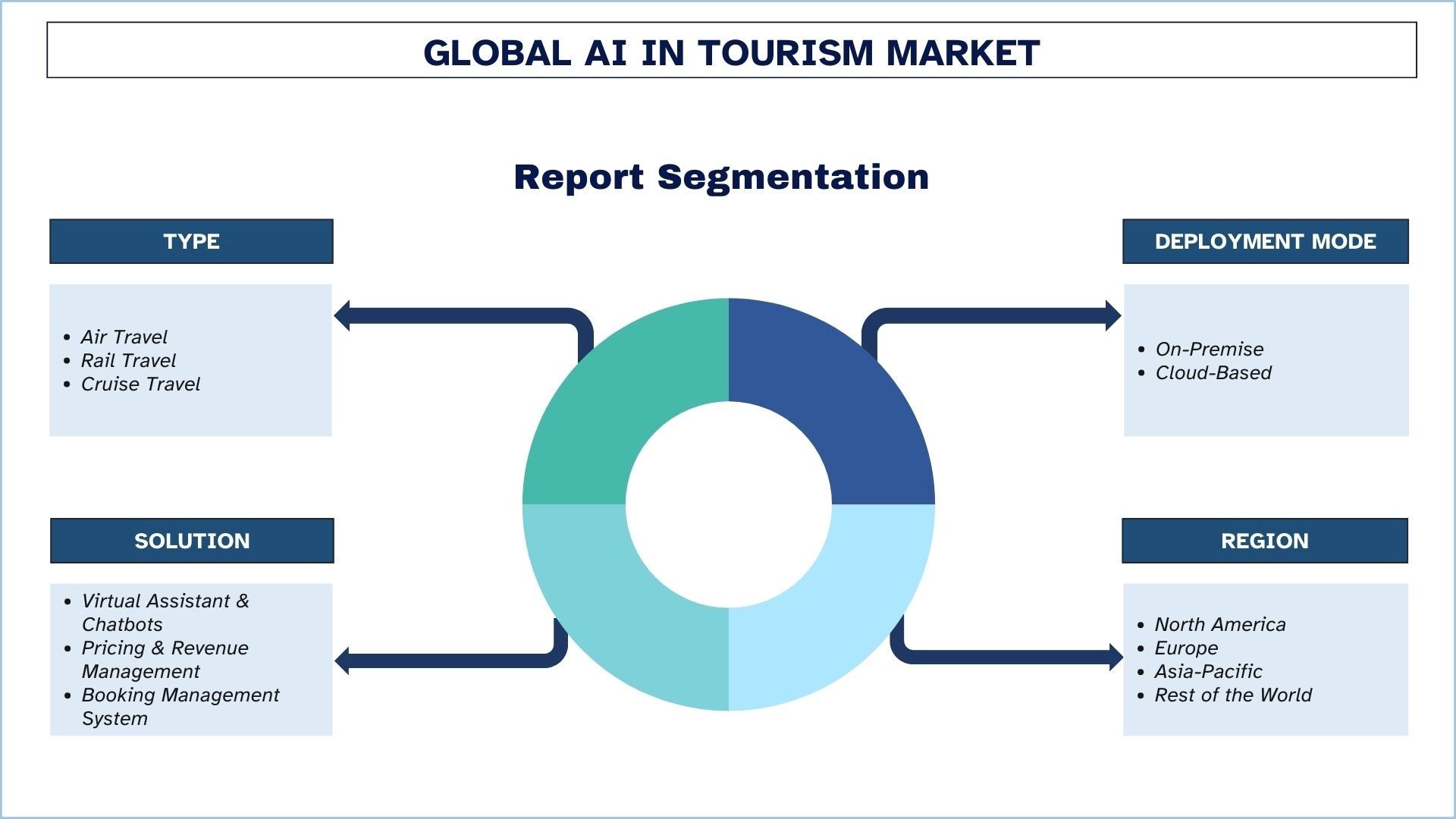
North America leads the market.
Artificial intelligence advances in the tourism sector have gained momentum across North America due to substantial funding of technological and innovative solutions. The region advantages from modern infrastructure alongside increased internet accessibility while keeping a powerful tourism sector. North American companies integrate AI technology to create optimized customer journeys by delivering tailored suggestions along with adaptable cost structures alongside intelligent chatbots aiding customer support interactions. Travel forecasting alongside demand pattern prediction uses predictive analytic capabilities through AI technology. AI technologies enable businesses to manage their resources more efficiently and minimize environmental impacts during tourism operations while sustainability becomes more important to the industry. For instance, on May 1, 2024, Mindtrip, an AI-powered platform that empowers everyone to travel differently, announced the consumer launch of its travel platform. Combining conversational AI with the rich and visual world of travel content, Mindtrip is the first travel platform in the market to cater to the fluid ways consumers travel.
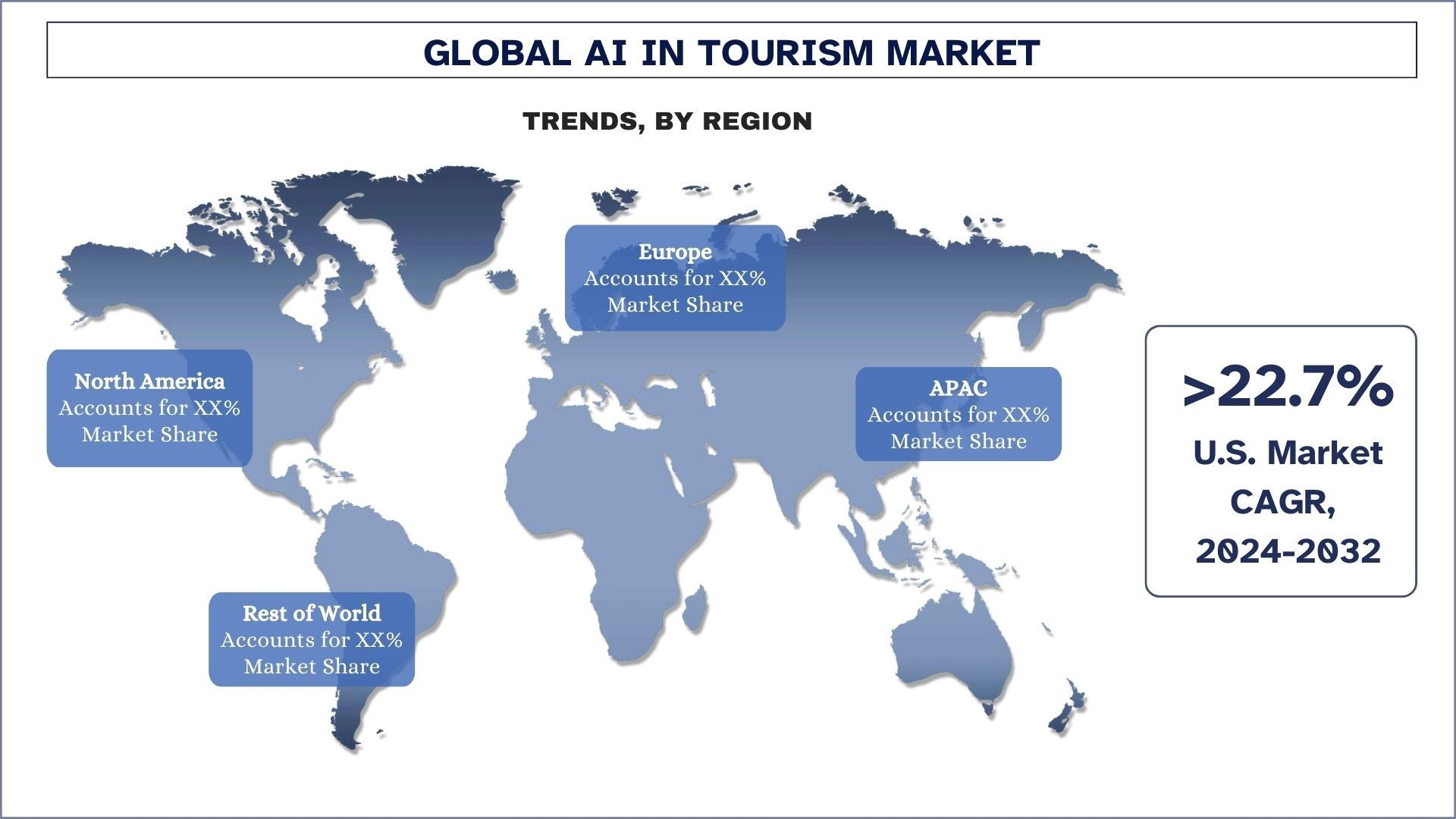
AI in Tourism Industry Overview
The AI in Tourism market is competitive, with several global and international players. The key players are adopting different growth strategies to enhance their market presence, such as partnerships, agreements, collaborations, new product launches, geographical expansions, and mergers and acquisitions. Some of the major players operating in the market are Snowflake Inc., NVIDIA Corporation, IBM, Microsoft, Amazon Web Services, Inc., Salesforce, Inc., HUAWEI Developers, Sabre GLBL Inc., SAS Institute Inc., Amadeus Hospitality.
AI in Tourism Market News
On December 06, 2024, Wipro Limited (NYSE: WIT, BSE: 507685, NSE: WIPRO), a leading technology services and consulting company, announced a collaboration with SIAM.AI, a member of the NVIDIA Cloud Partner program in Thailand. The companies will leverage NVIDIA accelerated computing and software to develop an AI-powered digital assistant for the Tourism Authority of Thailand. This collaboration will utilize infrastructure, data, and networks within the country, advancing Thailand’s sovereign AI objectives.
On November 7, 2024, The Saudi Tourism Authority (STA) unveiled SARA, a cutting-edge AI digital human developed to represent Welcome to Arabia as a brand ambassador, a travel companion and personal concierge.
On July 24, 2024, IGT Solutions (an EQT group company) and AuxoAI announced a strategic partnership to unlock productivity and profitability for clients in the Travel, Transportation, and Hospitality (TTH) industry. This collaboration marks the inception of IGTx, a new business unit within IGT Solutions that combines their existing Data and Digital strengths with AuxoAI's innovative IP, solution capabilities, and technology ecosystem relationships.
On April 9, 2024, IHG Hotels & Resorts, one of the world’s leading hotel companies, and Google Cloud, announced an expanded partnership that will fuel new customer experiences within the IHG One Rewards mobile app. With Google Cloud’s technologies, IHG will launch a generative AI-powered travel planning capability that can help guests easily plan their next vacation directly in the IHG One Rewards mobile app in a suite of new features that will launch in the second half of 2024, creating a more dynamic digital guest experience.
AI in Tourism Market Report Coverage
Report Attribute | Details |
Base year | 2023 |
Forecast period | 2024-2032 |
Growth momentum | Accelerate at a CAGR of 23.1% |
Market size 2023 | USD 3.1 Billion |
Regional analysis | North America, Europe, Asia-Pacific, Rest of the World |
Major contributing region | Asia-Pacific is expected to grow at the highest CAGR during the forecasted period. |
Key countries covered | U.S., Canada, Germany, France, UK, Spain, Italy, China, Japan, and India |
Companies profiled | Snowflake Inc., NVIDIA Corporation, IBM, Microsoft, Amazon Web Services, Inc., Salesforce, Inc., HUAWEI Developers, Sabre GLBL Inc., SAS Institute Inc., Amadeus Hospitality |
Report Scope | Market Trends, Drivers, and Restraints; Revenue Estimation and Forecast; Segmentation Analysis; Demand and Supply Side Analysis; Competitive Landscape; Company Profiling |
Reasons to buy this report:
The study includes market sizing and forecasting analysis validated by authenticated key industry experts.
The report presents a quick review of overall industry performance at one glance.
The report covers an in-depth analysis of prominent industry peers with a primary focus on key business financials, product portfolios, expansion strategies, and recent developments.
Detailed examination of drivers, restraints, key trends, and opportunities prevailing in the industry.
The study comprehensively covers the market across different segments.
Deep dive regional level analysis of the industry.
Customization Options:
The global AI in Tourism market can be customized further as per the requirement or any other market segment. Besides this, UMI understands that you may have your own business needs, hence feel free to connect with us to get a report that completely suits your requirements.
Table of Content
Research Methodology for the AI in Tourism Market Analysis (2022-2032)
Analyzing the historical market, estimating the current market, and forecasting the future market of the global AI in Tourism market were the three major steps undertaken to create and analyze the adoption of AI in Tourism in major regions globally. Exhaustive secondary research was conducted to collect the historical market numbers and estimate the current market size. Secondly, to validate these insights, numerous findings and assumptions were taken into consideration. Moreover, exhaustive primary interviews were also conducted, with industry experts across the value chain of the global AI in Tourism market. Post assumption and validation of market numbers through primary interviews, we employed a top-down/bottom-up approach to forecasting the complete market size. Thereafter, market breakdown and data triangulation methods were adopted to estimate and analyze the market size of segments and sub-segments of the industry. Detailed methodology is explained below:
Analysis of Historical Market Size
Step 1: In-Depth Study of Secondary Sources:
A detailed secondary study was conducted to obtain the historical market size of the AI in Tourism market through company internal sources such as annual reports & financial statements, performance presentations, press releases, etc., and external sources including journals, news & articles, government publications, competitor publications, sector reports, third-party database, and other credible publications.
Step 2: Market Segmentation:
After obtaining the historical market size of the AI in Tourism market, we conducted a detailed secondary analysis to gather historical market insights and share for different segments & sub-segments for major regions. Major segments are included in the report as type, deployment mode, solution, and regions. Further country-level analyses were conducted to evaluate the overall adoption of testing models in that region.
Step 3: Factor Analysis:
After acquiring the historical market size of different segments and sub-segments, we conducted a detailed factor analysis to estimate the current market size of the AI in Tourism market. Further, we conducted factor analysis using dependent and independent variables such as type, deployment mode, solution, and regions of the AI in Tourism market. A thorough analysis was conducted for demand and supply-side scenarios considering top partnerships, mergers and acquisitions, business expansion, and product launches in the AI in Tourism market sector across the globe.
Current Market Size Estimate & Forecast
Current Market Sizing: Based on actionable insights from the above 3 steps, we arrived at the current market size, key players in the global AI in Tourism market, and market shares of the segments. All the required percentage shares split and market breakdowns were determined using the above-mentioned secondary approach and were verified through primary interviews.
Estimation & Forecasting: For market estimation and forecast, weights were assigned to different factors including drivers & trends, restraints, and opportunities available for the stakeholders. After analyzing these factors, relevant forecasting techniques i.e., the top-down/bottom-up approach were applied to arrive at the market forecast for 2032 for different segments and sub-segments across the major markets globally. The research methodology adopted to estimate the market size encompasses:
The industry’s market size, in terms of revenue (USD) and the adoption rate of the AI in Tourism market across the major markets domestically
All percentage shares, splits, and breakdowns of market segments and sub-segments
Key players in the global AI in Tourism market in terms of products offered. Also, the growth strategies adopted by these players to compete in the fast-growing market
Market Size and Share Validation
Primary Research: In-depth interviews were conducted with the Key Opinion Leaders (KOLs) including Top Level Executives (CXO/VPs, Sales Head, Marketing Head, Operational Head, Regional Head, Country Head, etc.) across major regions. Primary research findings were then summarized, and statistical analysis was performed to prove the stated hypothesis. Inputs from primary research were consolidated with secondary findings, hence turning information into actionable insights.
Split of Primary Participants in Different Regions
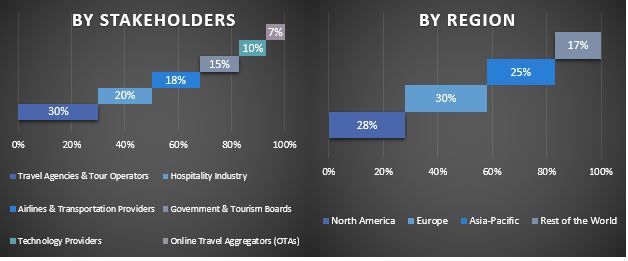
Market Engineering
The data triangulation technique was employed to complete the overall market estimation and to arrive at precise statistical numbers for each segment and sub-segment of the global AI in Tourism market. Data was split into several segments and sub-segments after studying various parameters and trends in the type, deployment mode, solution, and regions of the global AI in Tourism market.
The main objective of the Global AI in Tourism Market Study
The current & future market trends of the global AI in Tourism market were pinpointed in the study. Investors can gain strategic insights to base their discretion for investments on the qualitative and quantitative analysis performed in the study. Current and future market trends determined the overall attractiveness of the market at a regional level, providing a platform for the industrial participant to exploit the untapped market to benefit from a first-mover advantage. Other quantitative goals of the studies include:
Analyze the current and forecast market size of the AI in Tourism market in terms of value (USD). Also, analyze the current and forecast market size of different segments and sub-segments.
Segments in the study include areas of type, deployment mode, solution, and regions.
Define and analyze the regulatory framework for the AI in Tourism
Analyze the value chain involved with the presence of various intermediaries, along with analyzing customer and competitor behaviors of the industry.
Analyze the current and forecast market size of the AI in Tourism market for the major region.
Major countries of regions studied in the report include Asia Pacific, Europe, North America, and the Rest of the World
Company profiles of the AI in Tourism market and the growth strategies adopted by the market players to sustain the fast-growing market.
Deep dive regional level analysis of the industry.
Frequently Asked Questions FAQs
Q1: What is the AI in Tourism market's current size and growth potential?
The AI in Tourism market was valued at USD 3.1 Billion in 2023 and is expected to grow at a CAGR of 23.1% during the forecast period (2024-2032).
Q2: What are the driving factors for the growth of the AI in Tourism market?
The harnessing AI to support tourism innovation and sustainability, using AI to develop personalized tourist experiences, global adoption of chatbots and virtual assistants, and operational efficiency & automation drive the AI in Tourism market.
Q3: Which segment has the largest share of the AI in Tourism market by type?
Air Travel have the largest share of the AI in Tourism market by type.
Q4: What are the major trends in the AI in Tourism market?
The increasing adoption of voice assistants for booking and itinerary planning is the major trend in the AI in Tourism market.
Q5: Which region will dominate the AI in Tourism market?
North America dominated the market in 2023.
Related Reports
Customers who bought this item also bought

